#Battle of Bataan
Explore tagged Tumblr posts
Text

The 41st Infantry Division (Philippine Commonwealth Army) Defends the Abucay Line to Bataan
The 41st Infantry Division was a reserve division of the Philippine Commonwealth Army during World War 2. Its troops were from Region 4 of the Philippines and it was the 1st and only division raised from the region. Combining these numbers, the division, 41st, was created.
The 41st Division would be the first Philippine Army unit to reach the Bataan Peninsula when War Plan - Orange was activated. Under the command of Vicente Lim, the first Filipino graduate of the United States Military Academy at West Point, the division would fight and hold the center of the Abucay line on the right flank of the USAFFE defenses.
They would continue to fight at Bataan until its surrender.
----------------------------------------
Featuring:
Silver Wing (Me)
@f0rever-autumn
@randomgurustuffs
@temper-temper
#Silver Wing#f0rever-autumn#randomgurustuffs#temper-temper#FairChild#Art#Random Art#Pegasus#Pegasi#Lots of pegasi#Very much pegasi#Unicorn#MLP#My Little Pony#History#Philippine History#World War II#Battle of Bataan#Battle of the Abucay Line#Yea I know I said I was doing WW1 art#But I got distracted by the urge to do World War 2 art#Specifically the battle of Bataan hehe
37 notes
·
View notes
Text
Remember the Battle of Bataan: January–April 1942.
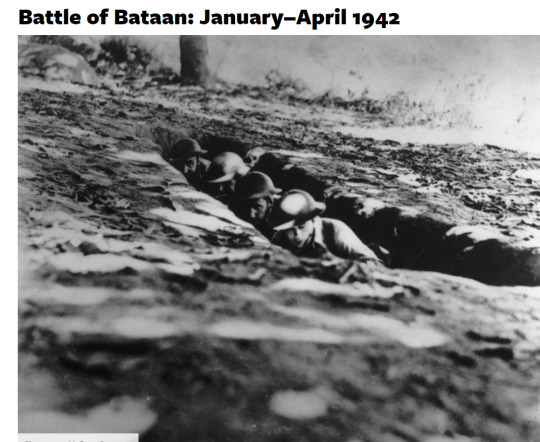
After the surprise attack on Pearl Harbor in December 1941, the Japanese launched a major offensive in the Philippines that eventually led to U.S. forces and soldiers of the Philippine Commonwealth to be cornered on the Bataan peninsula in the Philippines. Under direct orders from President Franklin Roosevelt, a reluctant General Douglas MacArthur escaped from Bataan to Australia, vowing one day to return and continue the fight.
Allied forces held off Japanese troops for three months, which stymied Japan’s hopes of growing its territorial gains in the Pacific theater. However, on April 9, 1942, 76,000 Allied troops surrendered to the Imperial Japanese Army; the transfer of those POWs from the battle became known as the Bataan Death March due to the physical abuse and arbitrary killings of prisoners along the way. “Remember Bataan” became a popular rallying cry for the U.S. war effort.
[Did You Know? The U.S. Never Successfully Fielded an Instant Foxhole Bomb, But Russia Sure Did]
#Battle of Bataan#second world war#Bataanpeninsula#Allied troops#Imperial Japanese Army#chronology#U.S. forces and soldiers
1 note
·
View note
Text

A Japanese soldier standing guard before American and Filipino POWs; more than 70,000 had been captured in the fall of the Philippines
10 notes
·
View notes
Text

Prisonniers américains et philippins pendant la marche de la mort de Bataan pour aller au camp de prisonniers de Cabanatuan – Bataille des philippines (1941-1942) – Luçon – Philippines – Avril 1942
©National Archives and Records Administration - 127-N-114541
De gauche à droite : Samuel Stenzler, Frank Spear et James McD. Gallagher.
Le soldat Samuel Stenzler est mort le 26 mai 1942 au camp O'Donnell sur l'île de Luçon à l'âge de 46 ans.
Le soldat de première classe Frank Spear de l'USAAF a été exécuté le 19 juillet 1945 par le Commandant du camp de prisonniers de Niigata sur l'île de Honshu. Il avait 26 ans.
Le Capitaine James McD Gallagher du 33rd Infantry Regiment, 31st Infantry Division est mort le 9 avril 1942 à l'âge de 27 ans pendant la marche de Bataan près d'Orani. Son corps ne fut jamais retrouvé (missing in action).
#WWII#guerre du pacifique#pacific war#bataille des philippines (41-42)#battle of the philippines (41-42)#marche de la mort de bataan#bataan death march#prisonniers de guerre#prisoners of war#pow#crimes de guerre#war crimes#luçon#luzon#philippines#04/1942#1942
5 notes
·
View notes
Text

You know how Ashley's entire arc in ME1 revolves around her family being ostracized by the Alliance for her grandfather's actions during the First Contact War? (This is the part of the date, where they go to the bathroom and never come back, btw)
I always felt the scapegoating of General Williams was especially horrible because he was thrown into an unwinnable battle. The Turians gained orbital superiority over Shanxi, and began striking anything that put up resistance.
Faced with either complete destruction, starvation or capitulation, an entire colony of civilians under his care Gen. Williams made the choice to surrender.
And apparently putting innocent lives before some pigheaded sense of honor? Paria for the rest of his life. Hell Ashley claims he'll go down in history beside Benedict Arnold (Who betrayed the infant United States to England during the AWI*) and Vidkun Quisling (The Nazi puppet leader of occupied Norway during WW2) when asked about his reputation.
*It's slightly my complicated then that but now isn't the time
He made a tough decision and people didn't like the outcome.
But the reason I bring this up is because I've always draw parallels with Shanxi being besieged and another battle that it reminds me of.
Bataan.
If you've never heard of it? So long as you're not Filipino or American I can't blame you. In those darkest days after the U.S entered WW2 an entire American army was to find itself fighting a forlorn hope on the Bataan peninsula 30 miles west of Manila after the Japanese invaded the archipelago.

For three months the American and Filipino forces fought a delaying action, waiting for reinforcements that were never to arrive. Bombed day and night as their guns fell silent. Artillery crashing down on them as their stomachs grew lighter from hunger. Day by day they were pushed backwards until almost completely out of supply and men having been fought to near exhaustion, their officers made the difficult choice to surrender.
That fell to Gen. Jonathan M. Wainwright, highest ranking officer left in the Philippines. Before his meeting with his Japanese counterpart, in telegram to President Roosevelt he explained his reasoning. I want to highlight a phrase he used that I think word for word describes Williams position perfectly.

"There is a limit of human endurance and that limit has long since been passed."
Something we're all familiar with as Mass Effect fans is having to make hard choices as a leader, that sometimes there isn't a 'Right' answer. Yet hidden in the lore of ME1 is probably one of the hardest choices in the series that we have nothing to do with.
But we understand.
#Mass Effect#fandom showerthoughts#ashley williams#First Contact War#randomly bringing up ww2#Not really sure where this goes in the second half#but i wrote it so im posting it#no refunds
27 notes
·
View notes
Text

Aircraft carrier USS Gerald Ford will return from mission in defense of Israel
The largest aircraft carrier in the United States returns from the Mediterranean Sea, where it has been parked for almost three months.
Fernando Valduga By Fernando Valduga 03/01/2024 - 08:27in Military, War Zones
The U.S. Navy has determined that its largest aircraft carrier, the USS Gerald R. Ford (CVN-78), will return home after a nearly three-month mission to defend Israel in the Middle East.
The USS Gerald Ford has been stationed at a close distance of Israel's attack in the Mediterranean Sea since October, in an effort to prevent the country's war against Hamas from turning into a regional conflict. However, the U.S. Navy states that the ship will begin its journey back home "in the next few days" and will be replaced by the USS Bataan - an amphibious assault ship named after a battle fought in the Philippines during World War II.
The USS Gerald R. Ford is one of the largest aircraft carriers in the world and the latest and most advanced aircraft carrier in the United States. He was already in the Mediterranean - involved in naval exercises with Italy - before receiving orders to provide support to Israel's Defense Forces after the October 7 terrorist attacks perpetrated by Hamas.
“Immediately after Hamas' brutal attack on Israel, the USS Gerald R. Ford Carrier Strike Group was ordered to go to the eastern Mediterranean to contribute to our regional deterrence and defense posture,” the U.S. Navy said in a statement.
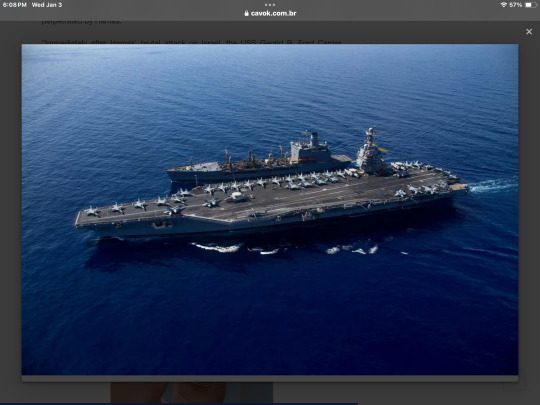
U.S. Defense Secretary Lloyd Austin extended Ford's detachment three times in the hope that his presence would dissuade Iran and groups aligned with Iran, especially Hezbollah from Lebanon, from attacking Israel.
The ship, which carried about 5,000 sailors and more than 100 warplanes in eight squadrons, is now returning to its naval base in Virginia. However, the USS Dwight D. Eisenhower will remain in the Red Sea to face the recent attacks on commercial ships perpetrated by Yemen's Houthi rebels.
“The DoD (Department of Defense) will continue to leverage its posture of collective force in the region to dissuade any state or non-state actor from escalating this crisis beyond Gaza,” the Navy said.
At the end of October, a U.S. Navy warship located in the northern Red Sea shot down three cruise missiles along with a batch of drones that were launched from Yemen and appeared to target Israel, the Pentagon said.
Tags: Military Aviationaircraft carrierUSN - United States Navy/U.S. NavyWar Zones - Middle East
Sharing
tweet
Fernando Valduga
Fernando Valduga
Aviation photographer and pilot since 1992, he has participated in several events and air operations, such as Cruzex, AirVenture, Dayton Airshow and FIDAE. He has works published in specialized aviation magazines in Brazil and abroad. He uses Canon equipment during his photographic work in the world of aviation.
Related news
BRAZILIAN AIR FORCE
FAB signs contract for logistical support of Armed Forces H225M aircraft
03/01/2024 - 08:07
B-2 over-volut at Rose Bowl 2024 in Pasadena, California. (Photo: Mark Holtzman / West Coast Aerial)
MILITARY
VIDEOS: How was the overfly of the B-2 bomber at the Rose Bowl on the first day of 2024
02/01/2024 - 20:01
MILITARY
South Korea selects ELTA Systems radar solutions for its new early warning aircraft
02/01/2024 - 16:00
MILITARY
Aero Vodochody will modernize the L-39ZA Albatros from Bulgaria
02/01/2024 - 14:00
ARMAMENTS
Raytheon guarantees $340 million contract to manufacture more StormBreaker pumps
02/01/2024 - 11:00
MILITARY
From 2024, Russian Aerospace Forces will receive Su-57 fighters with new AL-51F1 engines
02/01/2024 - 09:13
17 notes
·
View notes
Text
The Power of a Puppet (Wattpad | Ao3)
Accompanying Oneshot to The Consequence of Loyalty, taking place around the beginning of A Battle of Wills
Philippines head ached. It does that a lot nowadays, ever since Japan created the puppet government. A persistent ache consumed all of his head, making it hard to do anything and hard to think.
He supposed that was the point. After all, puppets weren’t meant to do anything without someone pulling their strings.
Kentucky was worried. Philippines could see it in the boy’s eyes whenever Kentucky looked at him, ever since the day the puppet was created, when Philippines was forced under the control of that government. Philippines knew he was lucky to have broken free then, lucky that a puppet state was not like martial law, that all he did was collapse to his knees and not attack Kentucky.
Philippines wouldn’t have ever forgiven himself if he killed Kentucky, even if it was under Japan’s control.
Right now, though, Kentucky was asleep, snoring awake in his makeshift bed. How that man slept so soundly in the jungles of Bataan, Philippines would never know. He was glad one of them was getting sleep.
Philippines had tried, but the pounding of his head, the foreign power he could feel pressing down on his limbs, locking them up as the ache in his head grew stronger—all of that made it hard to sleep.
And he was scared. Scared that if he did fall asleep, the puppet could take control, and he could never wake up again or wake up trapped in that prison in his own mind.
Sure, he had shaken off the puppet twice before, but there was never a guarantee that he would be able to do that every time. The more land they lost, the more people they lost, the harder it became for him. The stronger the ache in his head became.
It was already unbearable now. Who knew how worse it was going to get? The only relief was falling under the puppet’s control, but what kind of relief was that? What kind of relief was losing your fundamental right to control your own limbs, to speak when you wanted to, to walk and to cry and to laugh and to be human.
Philippines didn’t care if Japan didn’t support this. He didn’t care if she fought against the creation of a puppet state in his lands. He would never forgive her for this. Because even if she didn’t agree with it, she could still be the one controlling him.
A sudden bolt of pain in his head caused Philippines to gasp, grasping at his head as he tried to push off the control he could feel encroaching as his limbs stiffened.
“No!” he cried, “You aren’t going to take me!”
The pain reached an almost excruciating level as Philippines did his best to force the control away, watching in horror as the American flag slowly began fading away. Fear flooded through him, the cold fear that this time he would not be able to fight it off if it overtook him, that if he lost, he would lose forever.
He didn’t want to be a puppet. He was going to be a country in a few years! Why did Japan have to fucking take that from him? He may have his issues with America, but America never did this to him.
Philippine felt his knees buckle against his will as he lost the ability to control his legs. He was sobbing from the pain now, barely able to fight back due to it. It felt like a knife was being shoved into his brain over and over again.
Soon, however, he could not even cry as the puppet took complete control of him. He could still feel the tears from before on his face, but his crying had stopped.
He was a puppet again, trapped in his body, unable to move.
Almost mockingly, there was no more pain in his head. It felt fine, as if there had been no pain in it before.
Philippines wanted to scream and cry and rage and do something to express the anger and helplessness he felt. He wanted to do something to express his fear and frustration at losing to the puppet again.
But no matter how hard he tried, his limbs didn’t obey his commands, tears didn’t fall from his face, and his expression stayed empty.
Even then, Philippines refused to stay that way, to just sit down and do nothing as his body was taken away. This was his body and his land, and it would never belong to Japan and her army, not if he had something to say about it.
Philippines would fight tooth and nail and claw to keep his body, and like hell, he would stop now.
Fighting against the puppet government when it had already taken control was hard. Philippines had no control of his limbs, although that wouldn’t really help. It was hard to fight something that did not have a body, that was just a creeping presence in the back of your mind.
Still, Philippines had figured out ways to fight it. He needed to focus on one limb and concentrate all his focus on moving it. The puppet government was weird. Philippines wasn’t sure if it was because the government was so new or if it was because the government’s control over his land was limited, but from his two prior experiences of being completely controlled, as long as he was able to break something free, the rest of his body seemed to follow suit.
Philippines focused on his arm. It was the easiest one for him to do, as his legs were always pinned beneath the rest of his motionless body. He focused on moving it away from his head, on getting it to move, even just a little bit.
It was like pressing against a sapling. First, you could feel it begin to bend under the pressure, slowly being pushed closer and closer to snapping, until suddenly—
Philippines’ arm flew away from his head, nearly smacking against a nearby tree, as the control over it snapped. He let out a gasp as control returned to his body.
Of course, with the control returned the pounding headache.
Philippines didn’t care. The headache meant he was free.
For now.
Who knew when the control of the puppet government would overtake him again?
And who knew if he would be able to fight it off?
Philippines hoped so, but unless he got aid from America soon.
Well, they could hold out in Bataan for a while.
But not forever.
Eventually, he would fall to the puppet.
#countryhumans#oneshots by weird#historical countryhumans#the consequence of loyalty by weird#countryhumans philippines
4 notes
·
View notes
Note
So do you want to elaborate more about your parents and childhood?
[TL:DR: General Grievous gossips about his parents being the first step in giving him personality disorders. 98% headcanon]
“A common colloquial condemnation of one’s actions, to ask if their parents would be proud of them, yes? Very common on Kalee. You may be inclined to ask this of me: the Separatist scourge of the galaxy & hunter of Jedi. Believe me when I tell you, yes, they would be exceedingly proud of me.” General Grievous chuckled mischievously.
“What are my personal details worth to you, eh?” He reigned in a couple of coughs & waved a hand dismissively. “Only worth anything to my people & they already know! I will brief you on a summary, if only so that you may understand what is wrong with me in part, heheh.”
“My father, through his marriages, linked together all the tribes east of the wash in the Ausez steppes. Chieftain Rokrarri the Eye,” he tapped a claw to one of the porcelain sockets of his faceplate indicatively. “The locals were quite impressed by his longshot skill with the recently acquired rifles, as I understand. Supposed he could see clear across the plains. He was a fine warrior, put his clan before his own glory.”
“I imagine that was difficult with the way Honored liimumasyr treated him. How is it in Basic? My grandmother, yes? She was the one that orchestrated the marriage with the intention of keeping things together at home while most of the kolkpravis went to go fight the Republic’s battles for them. Father was not her first choice, though. First choice had been his brother, but he got himself got by Muja raiders. Not sure if it was better or worse that she had the bite to back up her bark, better than father at everything.”
“Honored liimuma fought through the entirety of the Bitthævrian War. Bataan Valgor’yz, ah, Splinter-Spite. No doubt the source of my inherited rage. She was very angry to have won the Republic’s war for them & gained nothing but glory. She never shut up about it, no? It was a punishment in my house: misbehave? Go to task with Honored liimuma, the most bitter kaleesh on the planet.” Grievous nodded sagely. “I suppose one could argue that I was born into an incredibly biased household,” he chuckled again, amused in a grim sort of way at how he seemed to be the epicenter of the Republic’s abuse of his people.
“She was not one to enjoy what you would call retirement. And her daughter, my liimasyr- my birth mother, was just a younger copy of her! I will tell you that kaleesh have accepted the fact that not all of us can be warriors but we are a bit further behind in the opposite. Not all kaleesh are cut out to raise pups no matter how divine of a duty anyone labels it."
Grievous then looked to you & tilted his head conspiratorially. You get the impression he'd be smirking if he could. "It is a sin to speak ill of one's mother, unit. I love her but, ah, Mother can come find me in hell if she wants to fight about it."
"My mother: Priving Aayaniz Blood-Feeder, Axe of the Eye, Daughter of the Kolkpravis. She was a fierce hunter & an insatiable glory hound. She had to be the best at all times. In a communal society she invented the sport of competitive parenting. I think perhaps she could have calmed down with time if it weren't for me. Because I hatched & I proceeded to be very good at everything I did."
"She was insufferable about it, unit. I was their trophy pup. My siblings stopped even trying to keep up with me. My father meant well trying to keep me close to him but that just meant I was given responsibilities & knowledge far beyond my years. So! You can see how being the responsible golden child translated into martyrdom...& when Dooku robbed me of my responsibilities all that was left was my maddening arrogance."
Grievous sounded amused by this, again in that twisted kind of way. The Sith had weaponized everything about him down to the traits that otherwise made him a demigod. Knowledge became arrogance, determination became spite, indignation became obsessive hatred.
#asks#in character#more info on his parents to come#accursed!grievous#I keep asks for years lol surprise bitch
7 notes
·
View notes
Photo

Medal of Honor Monday: Jose Calugas
On this day in 1942, a hero engages in an action that would earn him the Medal of Honor. Jose Calugas served in the Philippine Scouts of the United States Army during World War II. He received the Medal of Honor for his actions during the intense Battle of Bataan.
Who would have known that a mess sergeant on kitchen patrol duty would earn a Medal? Heroes come in all shapes and sizes, don’t they? :)
The Battle of Bataan was fought almost immediately after the Japanese attack on Pearl Harbor. The Japanese had invaded the Philippines, working to seize more and more land in the Pacific. The Philippine Scouts were immediately called into action.
“There was no provision for all the troops in the Philippines,” Calugas’s son later reported of this time. “No air power, no food, no medical supplies, no ammo . . . .” The situation was perhaps unsurprising, given that the United States had just been sucked unexpectedly into a war that it was trying to avoid.
The story continues here: https://www.taraross.com/post/tdih-jose-calugas-moh
#tdih#otd#this day in history#medal of honor monday#medal of honor#us army#world war ii#wwii#sharethehistory
86 notes
·
View notes
Note
hey, i got to the end of your working wwii ladies post and i was curious what books you'd recommend? and do you happen to know of any that go into nurses who had to deal with holocaust victims and pow survivors?
Hello, Kind Anonymous Friend! I'm so glad you found something you liked in that post.
I don't know of any books that deal specifically with only those topics, but I do know that two of my favorite overview books on nursing have chapters that talk briefly about prisoners of war and treating concentration camp survivors.
And If I Perish: Frontline U.S. Army Nurses in World War II, by Evelyn M. Monahan and Rosemary Neidel-Greenlee. Sisters In Arms: British Army Nurses Tell Their Story, Nicola Tyrer
Virginia Nicholson's Millions Like Us: Women's Lives during the Second World War also has several sections that deal with returning servicemen from a British civilian perspective.
If you are so inclined, there's also a group of US nurses who were also themselves POWs - the 11 Navy and 66 Army nurses who were imprisoned by the Japanese after the fall of Corregidor. Reading about their experiences could be informative as well.
Pure Grit: How American World War II Nurses Survived Battle and Prison Camp in the Pacific by Mary Cronk Farrell All This Hell: U. S. Nurses Imprisoned by the Japanese by Evelyn M. Monahan and Rosemary Neidel-Greenlee We Band of Angels: The Untold Story of the American Women Trapped on Bataan by Elizabeth Norman
There is also a group of Australian nurses who were held in POW camps in Sumatra.
7 notes
·
View notes
Text

The Philippine Army Air Corps' Baptism of Fire
December 10, 1941
The Philippines was at war. The US Naval base at Pearl Harbor was bombed by the Japanese Navy, while US Air Corps installations in the Philippines were bombed by Japanese aircraft from Formosa. These two attacks resulted in heavy loses on American ships and aircraft. With the destruction of most of the aircraft of the United States States Armed Forces - Far East (USAFEE), both the US and Philippine forces had to rely on the remaining US Air Corps aircraft, as well as the Philippine Army Air Corps' 6th Pursuit Squadron.
Under the command of Captain Jesus Villamor, the 6th Pursuit Squadron was deployed at Zablan airfield, ready to take to the air in an event of a Japanese air raid. On December 10, 1941, the pilots of the squadron heard the sound of distant church bells, thus alerting them to an impending air attack. Rushing to their outdated P-26 fighter aircraft, they began taking off just as Japanese Zero fighters started to strafe their airfield.
In the battle the followed, four P-26s fought against the more advance Japanese Zero fighters. Despite the disadvantage towards the Filipinos, the squadron managed to evade the Japanese fighters by hiding in the clouds. Because of this no Filipino aircraft was lost that day. The same could not be said for the Japanese, as they lost two fighters that day, with one kill going to Villamor and a probable kill going to Lieutenant Juliano.
Over the next few days, the Filipino fighter pilots in their P-26s would engage the Japanese in hit and run attacks. In the end the 6th Pursuit Squadron shot down three enemy planes, while losing two of their own in air battles.
By December 24, due to the rapid advance of Japanese ground forces, the Philippine Army Air Corps was forced to abandon their planes, while their personnel retreated to Bataan and Corregidor to help in the defenses there. Because of that the pilots and mechanics were forced to destroy their aircraft.
The Filipino pilots of the 6th Pursuit Squadron fought bravely, despite being outgunned. Their exploits are the legendary and are still remembered today. During the late 40s, as the Philippine Air Force was reorganizing, the 1st Fighter Squadron was redesignated as the 6th Fighter Squadron in honor of the legendary unit that fought in the early days of World War 2.
----------------------------------------
Featuring:
Rooster and @ask-jetstream as pilots of the 6th Pursuit Squadron rushing towards their aircraft during a scramble.
#Art#Random Art#Rooster#JetStream#MLP#My Little Pony#MLP Art#My Little Pony Art#Pegasus#Pegasi#ask-jetstream#Digital Art#History#Philippien History#WW2#World War 2#Philippine Army Air Corps#6th Pursuit Squadron
18 notes
·
View notes
Text
The History of Japanese-Philippines war
One Of my many favorite subjects is Ap! Ap is all about the history of Philippines. There are many battles that the Philippines were involved like the American-Philippines war, but we are talking about the Philippines-Japanese war. That happened on December 8, 1941 Shortly after the attack on Pearl Harbor, Japanese forces began their invasion of the Philippines. The initial landings took place on December 10, 1941, and Japanese forces quickly advanced, capturing key cities. General Douglas MacArthur, who was in command of the American and Filipino forces in the Philippines, declared Manila an open city to prevent its destruction, and he withdrew to the Bataan Peninsula.
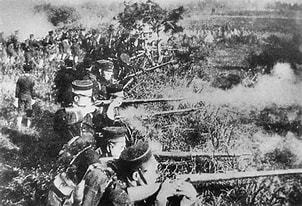
Bataan Death March (1942): The Battle of Bataan lasted from January to April 1942, during which the combined American and Filipino forces fought fiercely against the Japanese. However, due to overwhelming Japanese superiority and lack of reinforcements and supplies, the Allied forces were eventually forced to surrender. The infamous Bataan Death March followed, during which tens of thousands of Filipino and American prisoners of war were subjected to brutal conditions, resulting in the deaths of many.
occupation (1942-1945): With the fall of Bataan, the Philippines came under Japanese occupation. The Japanese established a puppet government headed by José P. Laurel, but resistance movements, including the guerrilla warfare led by Filipino and American forces, persisted throughout the occupation.
Liberation (1944-1945): The liberation of the Philippines began with the Allied forces' return. In October 1944, General MacArthur fulfilled his promise to return to the Philippines, leading the Leyte Landings. The Battle of Leyte marked the beginning of the end for Japanese occupation in the Philippines.
Battle of Manila (1945): The Battle of Manila, fought from February to March 1945, was one of the most intense urban battles during the Pacific War. The combined American and Filipino forces sought to recapture Manila from the Japanese. The battle resulted in significant destruction, and many civilians lost their lives.
End of the War (1945): The Philippines was officially liberated with the defeat of Japanese forces. The formal surrender of Japanese forces in the Philippines took place on September 3, 1945, aboard the USS Missouri in Tokyo Bay, marking the end of World War II in the Pacific.
Ty for reading my Blog
GOD BLESS ALL!
14 notes
·
View notes
Text

After years of occupation, the Battle of Manila began on February 3, 1945. The month-long campaign resulted in the death of over 100,000 civilians and the complete devastation of the city…
Please follow link for full post
Zaidan,Paintings,Bataan,Arthistory,Biography,Fernando Cueto Amorsolo,War,History,fineart,Artists,footnotes,
01 Work, The Art of War, Fernando Cueto Amorsolo's Hope in the Ruins of Manila, with footnotes
5 notes
·
View notes
Text
1/422/106-ID - Forced March (Mohn) The Fate of the American POWs of the 106-ID)
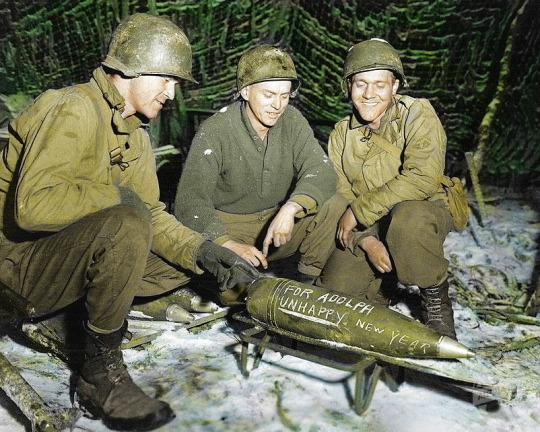
Source Document: Forced March Major John P. Mohn, HQ Co, 1st Battalion, 422nd Infantry Regiment, 106th Infantry Division

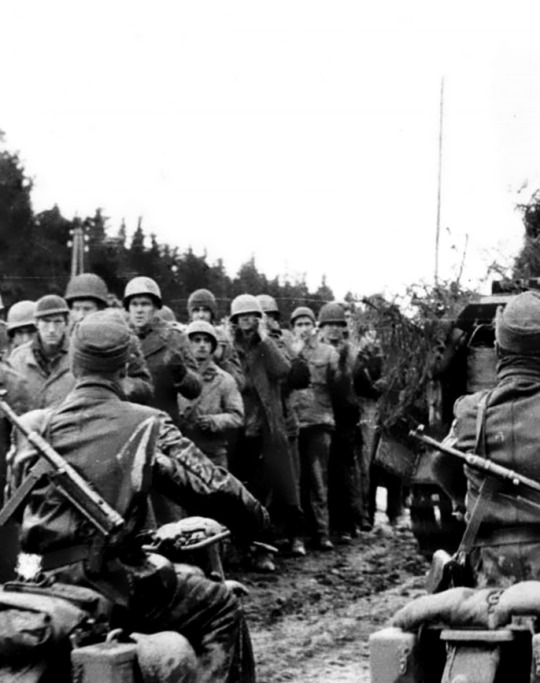
Forced March, from Schoenberg - St Vith (Battle of the Bulge, Belgium) to Berchtesgaden in Germany, is the Prisoner of War memoir of the 1200-mile forced march done by Maj John J. Mohn, Hq Co, 1st Battalion, 442nd Infantry Regiment, 106th Infantry Division, Golden Lion and has been extracted from a book published in Canton, Ohio, USA and printed by PPi Graphics, also in Canton Ohio, (ISBN-13:978-08-9863465-5-2). Being a friend of Mandy Altimus Pond, Maj John J. Mohn's granddaughter, we talked about the publishing of this book on the EUCMH Website and agreed that this work would be a great way to render honor to Maj John J. Mohn and the terrible period he experienced while being one American Prisoner of War in Nazi Germany during the last year of WW-2. Before starting with the text, I would like the reader to notice that combat photos from a surrendered unit in the combat zone don't exist, especially with the 422 and the 423-IRs of the 106-ID. On the morning of Dec 16, 1944, these two infantry regiments, were trapped between two German main axes of penetration; on their front, elements of the 5.Panzer-Army (Manteufeul) coming from Blieaf in Germany and heading to St Vith and on their rear, elements of the 6.Panzer-Army (Dietrich) coming from Lanzerath and Manderfeld heading to Liège via St Vith, didn't give a one of a chance to these two Regimental Combat Teams (422 and 423) which once cut off, without supply, couldn't withdraw in any direction. These men combated up to the last cartridge, then destroyed all their guns, machine guns, and rifles, and finally surrendered. Dedication To my wonderful wife, Cheri, and loving daughter, Debora Mohn Altimus; without whose prodding and encouragement this book would never have been written. And to my son-in-law Richard Altimus who assisted in the computer editing of this book. Editor's Note: Additional thanks to my granddaughter, Mandy Altimus Pond, who helped me with the publishing of her grandpa's book. Maj John J. Mohn, 1/442-IR, 106-ID

Foreword When WW II's Battle of the Bulge began with a surprise German attack on Dec 16, 1944, troops of the US 106th Infantry Division occupied the most exposed American positions. They had been in the European continent for less than two weeks and cut off from reinforcements, were left to face the German onslaught alone. They fought back, standing their ground, but as their ammunition; food and medical supplies dwindled and the enemy noose drew tighter, over 7000 were ordered by their commanding officers to surrender to the surrounding German forces. Except for the Bataan Death March, this was the largest surrender of American troops during WW II. Maj Mohn, of Akron, Ohio, the author of this book, was the Operations Officer of the 1/422-IR. He was a citizen-soldier who had volunteered to join the Army as a private in 1941. This is the story of his 1200-mile odyssey as a prisoner of war to the far reaches of the Nazi empire during which he and his fellow soldiers were starved, frozen, bombed, and shot. Because the Germans were unprepared to absorb a massive influx of American POWs and had little space to house them, Maj Mohn's imprisonment became an almost continuous five-month march through the collapsing and chaotic Third Reich. Initially, he was sent to a camp for American officers over 500 miles away from Poland. He

arrived there only to be marched out of the camp a few days later when the Russian forces broke through the German lines around Warsaw. Seeing the prisoners as a potential bargaining chip and intent on keeping them out of Russian hands, the Germans forced the Americans to make a harrowing march westward across rural Poland and Germany in the dead of winter just ahead of pursuing Soviet forces. After this month-and-a-half ordeal, the prisoners finally arrived at the Hammelburg POW Camp in northern Bavaria, only about 100 miles away from where they started. Two weeks later this camp was attacked and briefly captured by a Task Force of Patton's 3-A. The Germans, however, soon recaptured the camp and immediately sent Maj Mohn and the other prisoners on another dangerous march which ended at the Austrian border five weeks later they were liberated by American troops. Through it all, Maj Mohn preserved and returned to the USA where he underwent treatment and rehabilitation for injuries he had suffered as a prisoner of war. he returned to civilian life and developed a highly successful career as a psychologist. But his remarkable experiences in the military never quite left him. Eventually, he put words to paper and the result is the archive you are about to read - one of the very few accounts of this type ever to have been published. More than just a narrative of his experiences as a POW in Nazi Germany, it is a testament to the indomitable spirit of the US soldiers and a reminder to all of us of the sacrifices they made to preserve our freedom. Before the Battle of the Bulge - Mandy Altimus Pond


About 1937, while attending Akron University, John Mohn took Reserve Officers' Training Corps. John had no desire to become an officer, but by the end of his training, he had reached the rank of 2nd Lieutenant. In preparation for what appeared to be an inevitable world conflict, Congress passed the Selective Service Act in 1940. This was the first peacetime conscription in US history. Enacted in September 1940, this act required men between 21 and 35 years of age to register with local draft boards. Men were drafted by a lottery system and were required to serve for twelve months. After that year was completed, John was told he would be draft-free and not required to sign up, should a war arise. On Feb 4, 1941, John decided to enlist for this program and join the Navy. He drove to Cleveland, entered the Armory, and began the process. He took the written test, passed the physical, and was about to be sworn in when the commanding officer at the Armory said that John's teeth protruded too much and they would not accept him. John stated in an interview that 'this is stupid' and went to the other end of the Armory and enlisted in the Army. At this moment he could have enlisted as a 2nd Lieutenant because of his ROTC training. It slipped his mind and he enlisted as a Private.


John was assigned to the 37-ID at Camp Shelby, Mississippi. He volunteered for the Signal Company (Teletype) and the day after he signed up, the teletype was discontinued, so he was reassigned to supply in the Signal Company and was sent to Indiantown Gap Pa. On Dec 7, 1941, the Japanese attacked Pearl Harbor, and the next day upon request from President Franklin D. Roosevelt, Congress declared war on Japan and their ally Germany. This canceled the draft-free status that John had signed up for, as he had not completed his twelve months of training. His division was scheduled to board a ship headed to the Pacific Theater of the war, but the boat blew up before they could head out.

John was then sent to Fort Benning, Georgia, for officer training from February through April 1942. In late 1942, he was sent to Camp Forest and assigned to the 80-ID for a year. He became CO Fox Co, 1/319-IR, 80-ID. His division was in charge of clearing trees in the mountains in preparation for war games, training men in firing artillery, and surviving in realistic battle situations. John was in charge of the logistics and planning for the war games.
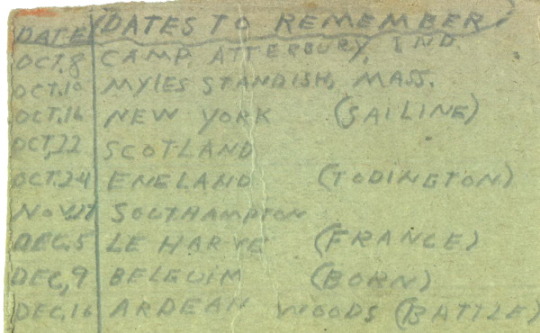
The 80-ID was then incorporated into the 106-ID. John was reassigned as Bn OP Officer and sent to Camp Atterbury, Indiana, and assigned to Hq Co, 1/422-IR, 106-ID. John reached the rank of Captain and was told that he was the youngest Captain in the Division. As Operations Officer, he was in charge of logistics for troop movements. He staged a large 3000-troop parade in Indianapolis in 1944. After our advance movement order was in, we received new equipment, turned in motor vehicles, and did what training we could at odd intervals. Finally, in September we moved by rail to Camp Myles Standish at Taunton, Mass. This place was known as a staging area where life reached the maximum of not letting anyone know anything at all. We existed on a monotonous routine of rumors until the day we redoubled our tracks, returned to New York, boarded the RMS Aquitania, and departed for Gourock, Scotland, on Oct 21, 1944. The 423-IR with various attached units arrived Oct 27, and the 422 and 424-IRs arrived Oct 28 with the artillery and some special units. We moved then to England where we were deployed in one of the most interesting and certainly the most beautiful parts of this country, the Cotswold section of the midlands. The 422-IR was stationed some 12 miles west and northwest of Oxford, the 424-IR near Banbury of Banbury Cross fame, and the 423-IR, and the Division Artillery near Cheltenham and Gloucester respectively. Division headquarters and special units were located centrally in this 200-square-mile area.
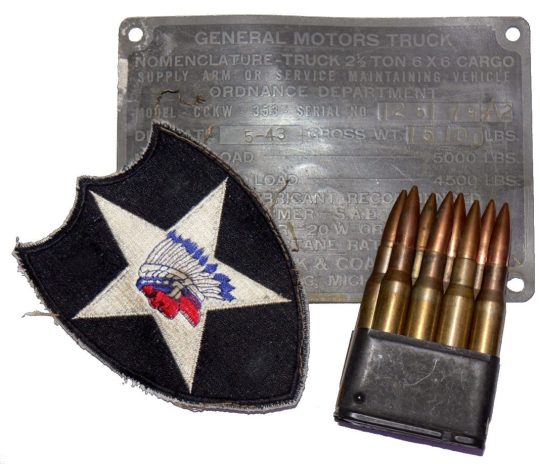
We remained in England preparing for an expected early crossing of the Channel. Between Nov 30 and Dec 1, the Golden Lions embarked on the long slow fifty-mile trip from Southampton to cross the Channel. We disembarked at Le Havre and at Rouen, a town about one-third of the way up the Seine toward Paris, and went into a bivouac in deep mud in the open fields in a cold drizzling rain, between the Dec 1/8.

During these days liaison officers from the 1-A headquarters arrived at odd intervals with conflicting and inconsistent sets of orders, so that during 48 hours we were assigned to three different corps in as many separate locations. Fortunately, troops and staff were arriving in unrelated groups as the weather and the Navy allowed them ashore so that no damage was done except to my disposition. The final messenger appeared on Dec 6 with instructions for us to leave for the St Vith area in Belgium. The first combat team to move, left the area on Dec 8, followed by the others as rapidly as possible. Upon arrival, we were to relieve the 2-ID, then in a defensive position, as part of the VIII Corps whose headquarters was then at Bastogne. Troops being in the throes of landing after a rough winter crossing, staffs only partly present and maps few and far between, our move to the battlefield was a rather remarkable one and highly successful despite its discomfort. The route carried us nearly 300 miles through Amiens, Cambrai, and Maubeuge in France to Philippeville in Belgium. After an overnight bivouac in extra deep mud near the latter town, we passed through Marche and the villages of eastern Belgium to the vicinity of St Vith, arriving during the period Dec 9/15. The relief of the 2-ID's weary troops stationed along the quiet German border in the Belgian Ardennes Forest commenced on Dec 11, and was completed on Dec 13, responsibility for the defense of the sector passing to me on Dec 12. The troops of the Indian head Division assured the men of the Golden Lion Division that there would be little action on this hilly terrain in the middle of winter. Edward P. McHugh

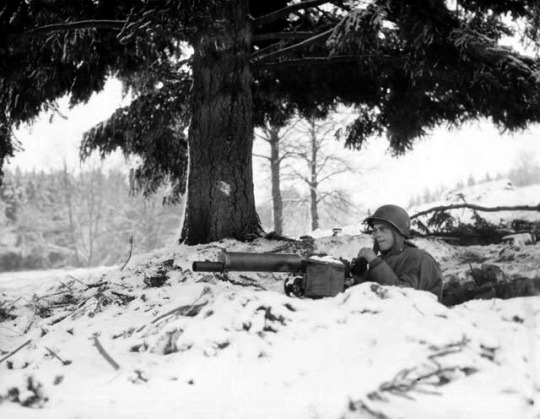
Preface - Maj John J. Mohn It was Dec 16, 1944, somewhere along the Siegfried Line near St Vith, Belgium. The German counter-attack that would later be referred to as the Battle of the Bulge had begun. The gray, foggy dawn made a perfect umbrella for the German launching of an onslaught that nearly cost the Allies World War Two. What happened at the Battle of the Bulge may be a well-known story but none of the stories make any reference to the group of American Soldiers taken prisoner at that time and marched for 140 continuous days covering over 1200 long, cold, starvation-ridden, nightmare miles, terminated only by the end of the war in Europe. Adversity is a mild term to describe the unbearable hardships endured by the ever-changing, ever-diminishing column of men. Temperatures dropped to ten degrees below zero (22°F). There were periods of fifteen days without a single bite of food. All suffered a phenomenal loss of weight (I weighed 65 pounds by the time of the liberation). We had inadequate clothing; many were without hats or gloves and at times no shoes. It was especially brutal for the poor Army Air Corpsmen who were only wearing thermal boots with no soles for walking when they were shot down and captured. The journey was marked by frozen feet, legs, arms, faces, and even blood trails. Treachery, deceit, and fear are just feeble attempts to put into words the anger, horror, anguish, and despair felt by these military men.

The ordeal that the approximately 7000 US soldiers endured between Dec 16/44 and May 2/45 can only be epitomized by saying that a scant thirty of the original group even reached liberation as a unit. Losses of men beyond belief resulted from attempts at escape, exposure, starvation, the sadism of the German Guards, and being strafed daily by our own and Allied planes. My book is not intended as a condemnation of the German People or Army but does make reference to differing attitudes and treatment by the Wehrmacht, to whom I owe a debt of gratitude for being alive, and the Elite SS Troops, who were constantly threatening our lives with attempts to exterminate us with machine guns and failed to provide even the most basic of necessities for our daily maintenance. The German High Command seemed at a loss as to what to do with so many prisoners and lacked a plan regarding the disposition of us. The result was a wandering march covering three countries with no apparent purpose, with a final goal of holding us as hostages in Berchtesgaden at the end of the war. The consequences for us, as Prisoners of War, were painfully clear. The facts and sequences of events I know first-hand because I was there from the beginning to the end. I saw dramatic changes in attitudes, values, behavior, and beliefs. Hidden strengths and weaknesses in the struggle for survival were surprising and at times frightening, but the salient factor through it all was that survival is 'All-Important' and that the 'Veneer of Civilization' is extremely thin.

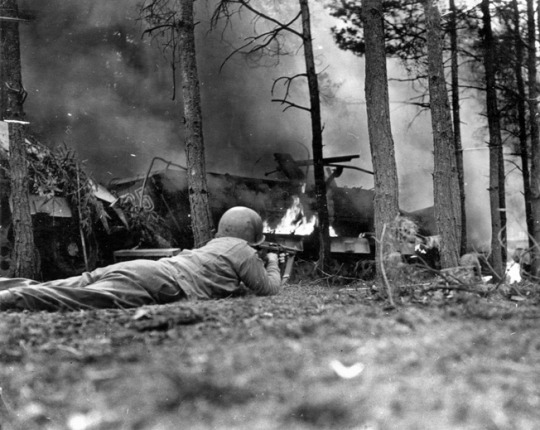
December 16, the Horror Begins I couldn't help being reminded of that famous poem by Rudyard Kipling 'The Charge of the Light Brigade' on that fateful, foggy, grey, cold, drizzling morning Dec 16, 1944. The difference was that instead of 'cannons' noted in the poem, we had German tanks to the left of us, tanks to the right of us, tanks in front of us, and tanks behind us. To 'charge' ahead would have been to go down the steep slope of an evergreen-covered mountain. The landscape was so much like the mountain areas of Pennsylvania that it was hard to remember that we were in a foreign country fighting a very serious war. Even more seriously, we were surrounded and annihilated by German Panzer Divisions from the left and right of us. German artillery from the front was terrible enough but, to our dismay, the Germans had captured our artillery and were using our guns to fire upon us from the rear. When we called for supporting fire, they were aiming at us instead of their troops. Our Battalion Commander, Col Thomas Kent was killed by a shell coming in from the rear of our 'Pillbox' command post. At first, we thought our artillerymen were firing short of their target, but when we heard the German voice on our radio, we realized the awful truth - we were literally at their mercy. The divide-and-conquer strategy used in the German attack had been completely unexpected and effective. Read the full article
#106thInfantryDivision#28thInfantryDivision#2ndInfantryDivision#3-A(US)#422ndInfantryRegiment#5.PA(German)#6.Panzer-Army#80-ID(US)#9-AD(US)#Afron#BalticSea#BataanDeathMarch#BattleoftheBulge#Belgium#Berchtesgaden#Bleialf(Germany)#CampMylesStandish#CampShelby#DeboraMohnAltimus#December1944#EdwardP.McHugh#Falkenberg#Fatherland#FortBenning#GenAllanW.Jones#GenevaConvention#Germany#HammelburgPWCamp#HQsCo1/422#IndiantownGap
2 notes
·
View notes
Photo




New Title Tuesday: Historical Fiction
Deep as the Sky, Red as the Sea by Rita Chang-Eppig
When Shek Yeung sees a Portuguese sailor slay her husband, a feared pirate, she knows she must act swiftly or die. Instead of mourning, Shek Yeung launches a new plan: immediately marrying her husband’s second-in-command, and agreeing to bear him a son and heir, in order to retain power over her half of the fleet.
But as Shek Yeung vies for control over the army she knows she was born to lead, larger threats loom. The Chinese Emperor has charged a brutal, crafty nobleman with ridding the South China Seas of pirates, and the Europeans—tired of losing ships, men, and money to Shek Yeung’s alliance—have new plans for the area. Even worse, Shek Yeung’s cutthroat retributions create problems all their own. As Shek Yeung navigates new motherhood and the crises of leadership, she must decide how long she is willing to fight, and at what price, or risk losing her fleet, her new family, and even her life.
A book of salt and grit, blood and sweat, Deep as the Sky, Red as the Sea is an unmissable portrait of a woman who leads with the courage and ruthlessness of our darkest and most beloved heroes.
The Long March Home by Marcus Brotherton and Tosca Lee
Jimmy Propfield joined the army for two reasons: to get out of Mobile, Alabama, with his best friends Hank and Billy and to forget his high school sweetheart, Claire.
Life in the Philippines seems like paradise--until the morning of December 8, 1941, when news comes from Manila: Imperial Japan has bombed Pearl Harbor. Within hours, the teenage friends are plunged into war as enemy warplanes attack Luzon, beginning a battle for control of the Pacific Theater that will culminate with a last stand on the Bataan Peninsula and end with the largest surrender of American troops in history.
What follows will become known as one of the worst atrocities in modern warfare: the Bataan Death March. With no hope of rescue, the three friends vow to make it back home together. But the ordeal is only the beginning of their nearly four-year fight to survive.
Inspired by true stories, The Long March Home is a gripping coming-of-age tale of friendship, sacrifice, and the power of unrelenting hope.
Loot by Tania James
Abbas is just seventeen years old when his gifts as a woodcarver come to the attention of Tipu Sultan, and he is drawn into service at the palace in order to build a giant tiger automaton for Tipu’s sons, a gift to commemorate their return from British captivity. His fate—and the fate of the wooden tiger he helps create—will mirror the vicissitudes of nations and dynasties ravaged by war across India and Europe.
Working alongside the legendary French clockmaker Lucien du Leze, Abbas hones his craft, learns French, and meets Jehanne, the daughter of a French expatriate. When Du Leze is finally permitted to return home to Rouen, he invites Abbas to come along as his apprentice. But by the time Abbas travels to Europe, Tipu’s palace has been looted by British forces, and the tiger automaton has disappeared. To prove himself, Abbas must retrieve the tiger from an estate in the English countryside, where it is displayed in a collection of plundered art.
The Lost Journals of Sacajewea by Debra Magpie Earling
Among the most memorialized women in American history, Sacajewea served as interpreter and guide for Lewis and Clark's Corps of Discovery. In this visionary novel, acclaimed Indigenous author Debra Magpie Earling brings this mythologized figure vividly to life, casting unsparing light on the men who brutalized her and re-centering Sacajewea as the arbiter of her own history.
Raised among the Lemhi Shoshone, in this telling the young Sacajewea is bright and bold, growing strong from the hard work of "learning all ways to survive" gathering berries, water, roots, and wood; butchering buffalo, antelope, and deer; catching salmon and snaring rabbits; weaving baskets and listening to the stories of her elders. When her village is raided and her beloved Appe and Bia are killed, Sacajewea is kidnapped and then gambled away to Charbonneau, a French Canadian trapper.
Heavy with grief, Sacajewea learns how to survive at the edge of a strange new world teeming with fur trappers and traders. When Lewis and Clark's expedition party arrives, Sacajewea knows she must cross a vast and brutal terrain with her newborn son, the white man who owns her, and a company of men who wish to conquer and commodify the world she loves.
Written in lyrical, dreamlike prose, The Lost Journals of Sacajewea is an astonishing work of art and a powerful tale of perseverance--the Indigenous woman's story that hasn't been told.
#historical fiction#fiction#new library books#New Books#new books to read#Book Recommendations#book recs#Reading Recs#reading recommendations#TBR pile#tbr#tbrpile#to read#Want To Read#Booklr#book tumblr#book blog#library blog
11 notes
·
View notes